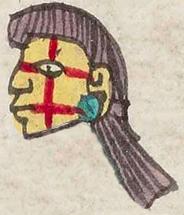Otomitl (Mdz3v)
This element for the Otomí ethnicity (otomitl) has been carved from the compound sign for the compound glyph for the place name, Otompan. It consists of a man's head, looking to our left. He has long hair, a turquoise earplug, a yellow face, and two red horizontal and one red vertical line (paint or tattoos) on his face. The lines intersect at his eye and on his cheek at about the height of his mouth.
Stephanie Wood
In this digital collection, face paint or tattooing has ethnic associations, involving Chichimecs, the Otomí, the Tlaxcalteca, and those who were “different” (e.g. the Tlamaca). Divine forces, such as Ecatl (or Ehecatl) and Xolotl, also have some face paint or tattoos.
As explained in our online dictionary, the Otomi language is spoken by an ethnic group that is different from the Nahuas. The languages are unrelated. The Otomies were known for having distinctive haircuts, which may be reflected in this glyph. Further research would be required to know if the face paint or tattoo shown in this glyph was a hallmark of this ethnicity.
See below for examples of glyphs showing a similar face paint or tattooing.
Nahuas and Otomies have lived in close proximity for a long time; the valley of Toluca is, for example, an Otomi region that was colonized by the Nahuas in the fifteenth century. The term otomitl can be found in sixteenth-century sources referring to migrants who came into the Tlaxcala region, to fierce opponents in war, and to simpletons, the latter reflecting an ethnic prejudice.
Stephanie Wood
c. 1541, but by 1553 at the latest
Stephanie Wood
Otomi, Otomies, ethnicities, tattoos, face paint, hairstyles, tatuaje

otomi(tl), a person who speaks Otomi, https://nahuatl.wired-humanities.org/content/otomitl
ethnic group
el otomí
Stephanie Wood
Codex Mendoza, folio 3 verso, https://digital.bodleian.ox.ac.uk/objects/2fea788e-2aa2-4f08-b6d9-648c00..., image 17 of 188.
The Bodleian Libraries, University of Oxford, hold the original manuscript, the MS. Arch. Selden. A. 1. This image is published here under the UK Creative Commons, “Attribution-NonCommercial-ShareAlike 3.0 License” (CC-BY-NC-SA 3.0).





